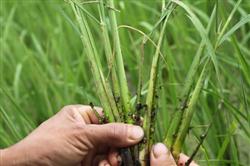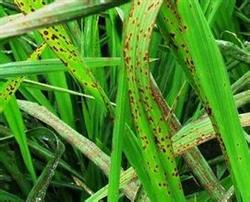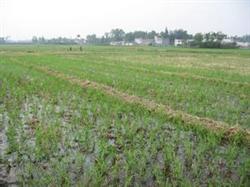Opinions on the Control of Disease and Cordyceps in Rice Field

1. Control of rice stripe blight 1. Control of virus-borne gray planthopper: Rice stripe blight has become an important disease on rice in our county. This year, the number of gray planthopper in our county is high, the virus-carrying rate is high, and the development is fast. Stripe blight will be a major occurrence trend. According to the survey, the number of insects per mu of the first generation of gray planthopper reached 150000 in the wheat field this year; the adults migrated into the seedling field on May 25, and the number of insects in the seedling field began to surge on May 30. The number of insects per mu in the seedling field during the peak period reached 18000, and some fields reached 52000; the virus-carrying rate of overwintering generation gray planthopper and the first generation gray planthopper was 40.2% and 24.3%, respectively, which greatly exceeded the pandemic target. The second generation of gray planthopper is the main harmful generation in our county, and the control of the second generation of gray planthopper in the field is the main measure to control the occurrence of rice stripe blight. Control methods: about 7 days after throwing seedlings, 30 grams of 10% aphid lice per mu of all rice fields should be controlled once; about 7 days after the first drug, the weeds on the edge of the field should be used at the same time. In addition, transplanting with medicine in the seedling field must also be in place. On the basis of the previous control of wheat and rice fields, there will be another control from June 20 to 25. 2. Spraying antiviral agents: combined with the control of gray planthopper, spray water evenly with 20% rice Ankang 100ml per mu each time. 2. Field chemical removal 1, throwing seedling field chemical removal: (1) Rice seedling throwing 7 days, 53% silver hoe per mu selected one bag (50 grams), mixed with wet fine soil 20 kg, the field to establish a water layer, after the dew is dry, evenly spread, keep the water layer for more than 5 days. When using medicine, we should pay attention to: first, the dosage should be accurate, and the mixture should be evenly mixed; the second is to strengthen the management of water slurry, to maintain the water layer in order to improve the control effect, and at the same time to do a good job of flat water shortage to prevent flooding of heart leaves; third, to use medicine immediately after the establishment of rice seedlings, on this basis, early use of drugs is beneficial to improve the control effect; fourth, to prevent chemicals from polluting other crops. (2) about 10 days after throwing rice seedlings, 25% rice nongle 1 bag (40 grams) per mu was selected. After draining the field water layer, the appropriate amount of water was uniformly fine sprayed, and the field water layer was established and maintained one day after the medicine. Attention should be paid to the use of quasi-dosage, such as the amount of grass should be appropriately increased when the grass age is older, and at the same time to prevent pollution of other crops. 2. chemical removal of wheat and rice fields: after the wheat harvest is ready to dry, after 2.5 leaves of rice, choose 25% of rice nongle 1 bag (40 grams) per mu, spray the water evenly and fine spray, establish a water layer in the field one day after the medicine and keep water. When using medicine, it is necessary to increase the dosage when the field barnyardgrass is more than three leaves or when there is more grass, water conservation is the key to improve the control effect, and at the same time to prevent pollution of other crops. Third, the prevention and control of rice weevil this year, the occurrence of rice weevil in our county is relatively light, so in terms of prevention and control, we should focus on the intercropping of wheat and rice and do a good job in prevention and control. Wheat and rice should be controlled immediately after watering, and about 7 days after seedling throwing, the pesticide should be used together with the control of gray planthopper.
- Prev

Symptoms of Zinc deficiency in Rice and skillful Application of Zinc Fertilizer in Rice Field
Zinc is one of the necessary trace elements in the growth and development of rice. Zinc deficiency in rice will show obvious symptoms. Due to zinc deficiency, chlorotic yellow and white spots, upper reddish brown spots and irregular patches appeared in the lower leaf vein area, then gradually enlarged as reddish brown stripes, turned reddish brown and dried up from the leaf tip downward.
- Next

Key points of no-tillage rice seedling throwing operation
Rice no-tillage seedling throwing refers to a new rice cultivation project in which no-tillage and harrowing rice fields are harvested last season without any ploughing and harrowing, first using herbicides to kill weed plants and irrigating rice seedlings, destroying withered rice piles, irrigating and fertilizing the field, and after the water layer naturally dries or drains shallow water, a new rice cultivation project in which plastic tray seedlings or paper tube seedlings are thrown into the field.
Related
- The first cup of black tea in spring, the flavor and history of tea gardens in Kenya, Africa
- The computer can not only choose potatoes, but also grow tea rice. AI will grow winter oolong tea champion.
- It is not only the inflated tea bitten by insects, but also engraved with the four seasons tea in Beipu.
- The Oriental Beauty Tea Festival in Zhuxian County takes the stage at the weekend to experience the plus-size feast of oil tea.
- & quot; Oriental Beauty Tea & Exploration of Emei in Hsinchu, the hometown of quot;
- The new variety of strawberry "Tainong 1" dessert is the first choice with mellow aroma. Crimson gorgeous
- History of Tea in Taiwan: from Wild Inner Mountain to Export Tea Garden
- Two types of Taiwan Oriental Beauty Black Tea won the British three-Star Award for Childhood Tea Xiang Zhang Jiaqi changed from pilot to champion tea maker.
- Banana species and varieties: the planting history of Taiwan Xianren banana and dwarf banana is long, is banana disease resistant?
- Coffee planting Technology: Qianjie Coffee from Seedling to harvesting

